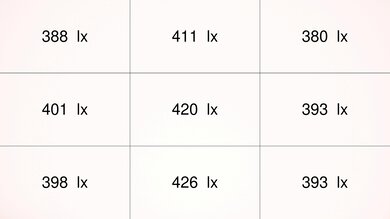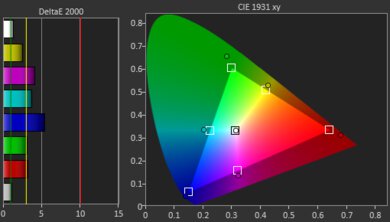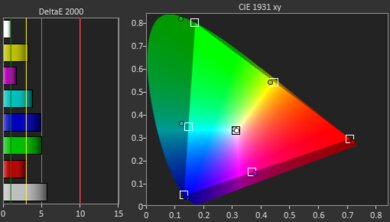The Hisense C1 is a 4k DLP laser projector. It's a standard throw projector with a fixed lens, but it has a digital zoom feature that allows it to project an image anywhere from 65" to 300". It's the first standard-throw projector from Hisense to implement a TriChroma triple laser engine, with a remarkably wide color gamut for HDR content and support for Dolby Vision, as well as two integrated 10W JBL speakers and Dolby Atmos support. Its all-in-one design is rounded out with built-in streaming apps through Vidaa OS, digital geometry correction features like auto keystone correction and obstacle avoidance, and a relatively portable design in case you want to move it from room to room.
Our Verdict
The Hisense C1 projector is a good choice for watching movies. The projector gets decently bright and has great native contrast, producing a crisp and pleasing image, though it's best suited for dark or light-controlled rooms. It also supports Dolby Vision HDR and has near-full coverage of the Rec. 2020 color gamut, making HDR content look vibrant. That said, SDR content can look oversaturated. Colors are quite accurate out of the box, though white balance issues can leave a reddish cast unless you calibrate it.
-
Decently bright image, especially for dark rooms.
-
Supports Dolby Vision.
-
Very wide color gamut for HDR content.
-
Great native contrast ratio, with punchy highlights and well-defined shadows.
-
Not quite bright enough for rooms with ambient light.
-
SDR content can look oversaturated.
- 7.6 Movies
Changelog
- Updated May 21, 2024: Updated text throughout the review according to Test Bench 0.9, mainly in the Compared To Other Projectors and Contrast sections.
- Updated May 21, 2024: We've converted this review to Test Bench 0.9. We've overhauled our Contrast tests, as we now measure contrast at various average pixel levels (APL). You can see the full changelog here.
- Updated Feb 22, 2024: Review published.
- Updated Feb 21, 2024: Early access published.
Check Price
Differences Between Sizes And Variants
The Hisense C1 projector comes in one color: Prussian Blue. There are no other variants of this model.
Our unit was manufactured in June 2023; you can see the label here.
Compared To Other Projectors
The Hisense C1 is a good lifestyle projector for those seeking a relatively portable room-to-room projector to watch movies and TV shows. Though it's missing features like optical zoom or a gaming mode, it supports Dolby Vision, and its triple laser design produces vibrant colors and a fairly bright image. It's also relatively compact and has auto-adjustment features, making it a good fit for smaller spaces or room-to-room usage. However, as it doesn't have optical zoom, you'll ideally need to physically adjust its placement to get the best image for your screen. Still, it offers excellent value for those seeking an all-in-one home theater solution at this price point.
See our recommendations for the best projectors for home theater and the best home projectors. If you're looking for something more general, look up our list of the best projectors instead.
The Hisense C1 and the XGIMI HORIZON Ultra are both good all-in-one projectors with Dolby Vision support. The Hisense has better contrast overall and more vibrant colors, thanks to its triple laser design. On the other hand, the XGIMI gets notably brighter, so it's better for setups with ambient light, and its optical zoom gives you more flexibility with placement.
The Epson Home Cinema 3800 is better than the Hisense C1. The Epson has a more traditional design, while the Hisense is aimed at those who want an all-in-one projector; that is, it's more compact and has a smart OS for built-in streaming. The Epson gets much brighter, making it better suited to rooms with ambient lighting, and its optical zoom gives you more flexibility with placement. However, in a dedicated room where you can control its placement, the Hisense has much to offer, including a sharp, vibrant image and Dolby Vision support.
The Hisense C1 and the BenQ X3000i are both great lifestyle projectors, though the BenQ is better suited to gaming thanks to its low input lag gaming mode. The BenQ also gets brighter, making it a better fit for moderately lit rooms, while the Hisense's edge in its contrast makes it better suited for dark rooms. The BenQ's optical zoom also gives you more flexibility with placement. Conversely, the Hisense is better for HDR content, with a wide color gamut and Dolby Vision support.
The Hisense C1 is much better than the Samsung The Freestyle 2nd Gen, but they're in different product classes. The Samsung The Freestyle 2nd Gen is a small portable projector with a nifty tilting stand that lets you adjust the projection angle. The Hisense is a bigger product, although it's not huge, and like the Samsung, it comes with a full suite of image correction features, so it's not too much of a hassle to move around. Otherwise, the Hisense offers much better image quality due to its higher peak brightness, better contrast, and sharper image due to its pixel-shifting technology.
The BenQ HT4550i is better than the Hisense C1. It gets significantly brighter and displays more accurate colors, though the Hisense has better contrast, so it looks better in dark rooms. The optical zoom on the BenQ gives you more flexibility with placement, and ports like a 12V trigger make it more suitable for a dedicated home theater setup. That said, the Hisense may be a better-value option for those who just want an all-in-one solution.
Test Results
The Hisense C1 is billed as a "mini" projector, and though its boxy design isn't exactly compact, it is relatively portable and isn't too much of a hassle to move from one room to another. It's smaller and lighter than the BenQ X3000i and roughly similar in size and weight to the XGIMI HORIZON Ultra.
It has a range of automatic adjustment features, including auto keystone correction, autofocus, and digital zoom, making it fairly easy to move and set up in a new spot.
This is a DLP projector with a triple laser light source. Unlike a single laser projector, it uses three separate red, green, and blue lasers to produce its colors. Hisense rates it for over 25,000 hours of use, so you won't have to worry about the lasers dimming over time or needing replacement. The projector uses pixel shifting to display a 4k image, and though it isn't quite as sharp as a native 4k projector, it's the next best thing.
Unfortunately, it uses a fixed lens, making it a bit trickier to position correctly. However, it does have a digital zoom feature that lets you adjust the image to fit screens ranging from 65" to 300", as well as geometric adjustment features like keystone correction, though there's no lens shift feature.
The Hisense C1 has decent peak brightness. It's rated for 1600 ANSI lumens, though we measured closer to 1000 in our light-controlled testing setup. It isn't the brightest projector out there—it doesn't get nearly as bright as the XGIMI HORIZON Ultra, for instance—but it's still bright enough to look good in dark rooms. Thankfully, the brightness is also very uniform across the whole screen.
The Hisense Cube C1's contrast ratio is great. Highlights and shadows are well-defined, leading to a very pleasant viewing experience in darker rooms.
The Hisense C1 projector's color accuracy is okay out of the box. It displays colors quite accurately, likely helped by its triple laser design, and gamma follows the 2.2 target curve closely for the most part. However, its white balance is very off, and the color temperature is overly warm, so the image has a reddish tint.
After calibration, the color accuracy is significantly better. Colors are further improved, with only minor inaccuracies. White balance and color temperature are also much better. The projector includes 20-point white balance calibration, allowing for more precise fine-tuning.
The Hisense C1 has a very wide color gamut, with nearly full coverage of the Rec. 2020 color space, making it a good fit for HDR content. That said, its color gamut exceeds the Rec. 709 color space used in SDR content, which can result in oversaturated colors.
This projector runs Hisense's VIDAA OS smart platform and has several pre-installed apps, including Netflix and other major streaming apps. You can also cast content from your phone.
It has two integrated 10W JBL speakers and even supports Dolby Atmos, though you won't get nearly the same immersion as you would with dedicated speakers.
There are two HDMI 2.0 ports, including one eARC port. The projector also has one USB 2.0 port and one USB 3.0 port. On top of that, there's an ethernet port, an optical digital audio out port, and a 3.5mm audio out. However, there's no 12V trigger port to automatically drop or retract a motorized screen when powering the projector on/off.
























